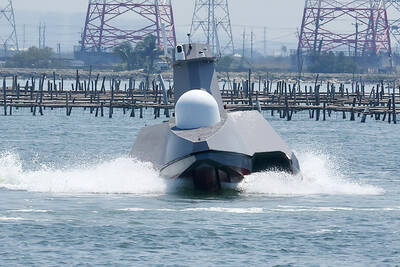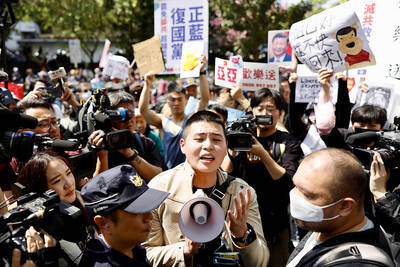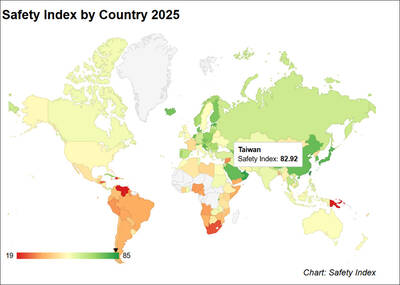Taiwanese artists have raised concerns about a Beijing art gallery’s plans to open a branch in Taipei in April, even before the legislature has begun its review of the cross-strait service trade agreement signed last year.
Beijing-based Aura Gallery is setting up a branch, with registered capital of about NT$150 million (US$5.06 million), on Taipei’s Dunhua S Road.
The gallery decided to set up a branch in Taipei because of the strong purchasing power of the city’s residents and their appreciation of art, but it had no plans to shift its focus from Chinese contemporary art and photography or to represent Taiwanese artists, Taipei branch art director Huang Ya-chi (黃亞紀) said.
The average annual sales volume of Taipei’s art market is about NT$5 billion, according to Taiwan Art Gallery Association statistics.
The Beijing gallery’s scheduled entry has alarmed Taiwanese artists, who say they already have a hard time competing against their Chinese counterparts.
Taipei-based InSian Gallery director Ou Shih-hao (歐士豪) said China has given little credit to Taiwanese art and artists, as evidenced by the failure of the globally renowned Juming Museum to make the list of China’s top 50 art museums.
The museum in New Taipei City’s Jinshan District (金山) showcases the work of Ju Ming (朱銘), the nation’s best-known sculptor.
“Over the past two years, a number of Chinese investors have expressed an interest in renting warehouses in Taipei’s Huashan 1914 Creative Park and Songshan Cultural and Creative Park for exhibitions, but I never thought they would one day enter [Taiwan’s market],” Ou said.
Ou said he was deeply worried about what would happen to Taiwanese artists if the legislature ratifies the service trade accord. They could be left vulnerable to Chinese-funded galleries’ ill-intentioned efforts to stifle their vitality and creativity by turning them into “mama’s boys,” he said.
Taiwanese artist Huang Chia-liang (黃家良) said although he has staged two solo exhibitions and taken part in a number of joint ones, he still has a difficult time finding a gallery willing to represent him because of the apparent shift in the local art market in recent years to Chinese painters.
“It takes at least five years for young Taiwanese artists to be noticed... I am afraid the passage of the service trade agreement may bode ill for their dreams of becoming professional artists,” Huang said.
Chow Mei-li (周美里), the Taiwan Solidarity Union’s policy and publicity director, said that under the WTO framework, Taiwan’s retail sector has only been slightly open to China — as required by an executive order, which is still subject to repeal.
“However, if the service trade accord is ratified, there will be something of a ‘controlling spell’ on Taiwan. There is a good chance that after Chinese-funded galleries gain a foothold, they might join hands with other Chinese-funded companies to provide end-to-end tourism service … which could pose a serious challenge to local galleries,” Chow said.
National Taiwan University economics professor Kenneth Lin (林向愷) said the ratification of the service trade pact would allow deep-pocketed Chinese investors to monopolize Taiwan’s art market and help Beijing enforce its “united front” tactics in the cultural sector.
“Since every piece of artwork is irreplaceable, Chinese investors could easily drive local art galleries out of business by buying up their best collections and prohibiting Chinese artists from approaching them to show their work,” Lin said.
The service trade agreement, which was signed in June last year, has been stalled in the legislature because of objections from opposition lawmakers, who are concerned that it will harm the nation’s interests.
President Ma Ying-jeou (馬英九) has repeatedly urged lawmakers to begin reviewing the agreement as soon as the last hearing on it is held next month.
He said that any delay in ratifying the pact will create doubt in the international community about Taiwan’s willingness to abide by or take part in international trade accords or blocs.
Additional reporting by CNA

ENDEAVOR MANTA: The ship is programmed to automatically return to its designated home port and would self-destruct if seized by another party The Endeavor Manta, Taiwan’s first military-specification uncrewed surface vehicle (USV) tailor-made to operate in the Taiwan Strait in a bid to bolster the nation’s asymmetric combat capabilities made its first appearance at Kaohsiung’s Singda Harbor yesterday. Taking inspiration from Ukraine’s navy, which is using USVs to force Russia’s Black Sea fleet to take shelter within its own ports, CSBC Taiwan (台灣國際造船) established a research and development unit on USVs last year, CSBC chairman Huang Cheng-hung (黃正弘) said. With the exception of the satellite guidance system and the outboard motors — which were purchased from foreign companies that were not affiliated with Chinese-funded

PERMIT REVOKED: The influencer at a news conference said the National Immigration Agency was infringing on human rights and persecuting Chinese spouses Chinese influencer “Yaya in Taiwan” (亞亞在台灣) yesterday evening voluntarily left Taiwan, despite saying yesterday morning that she had “no intention” of leaving after her residence permit was revoked over her comments on Taiwan being “unified” with China by military force. The Ministry of the Interior yesterday had said that it could forcibly deport the influencer at midnight, but was considering taking a more flexible approach and beginning procedures this morning. The influencer, whose given name is Liu Zhenya (劉振亞), departed on a 8:45pm flight from Taipei International Airport (Songshan airport) to Fuzhou, China. Liu held a news conference at the airport at 7pm,

Taiwan was ranked the fourth-safest country in the world with a score of 82.9, trailing only Andorra, the United Arab Emirates and Qatar in Numbeo’s Safety Index by Country report. Taiwan’s score improved by 0.1 points compared with last year’s mid-year report, which had Taiwan fourth with a score of 82.8. However, both scores were lower than in last year’s first review, when Taiwan scored 83.3, and are a long way from when Taiwan was named the second-safest country in the world in 2021, scoring 84.8. Taiwan ranked higher than Singapore in ninth with a score of 77.4 and Japan in 10th with

GRIDLOCK: The National Fire Agency’s Special Search and Rescue team is on standby to travel to the countries to help out with the rescue effort A powerful earthquake rocked Myanmar and neighboring Thailand yesterday, killing at least three people in Bangkok and burying dozens when a high-rise building under construction collapsed. Footage shared on social media from Myanmar’s second-largest city showed widespread destruction, raising fears that many were trapped under the rubble or killed. The magnitude 7.7 earthquake, with an epicenter near Mandalay in Myanmar, struck at midday and was followed by a strong magnitude 6.4 aftershock. The extent of death, injury and destruction — especially in Myanmar, which is embroiled in a civil war and where information is tightly controlled at the best of times —